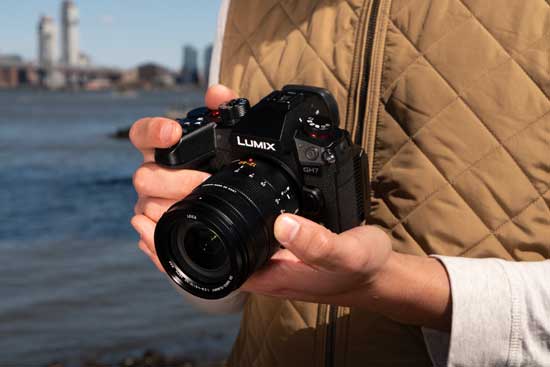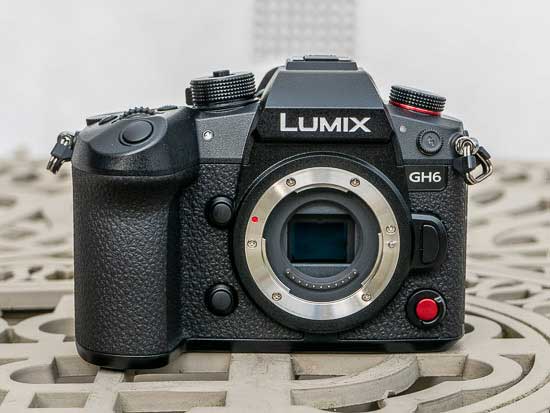
The Lumix GH6 hybrid photo and video mirrorless camera was launched in 2022, and we absolutely loved it, awarding it our highest 5-star Essential rating and commenting that “the new Panasonic Lumix GH6 delivers virtually everything that an aspiring one-man/woman videographer could ever want from a hybrid camera.”.
Until the launch of the new Lumix GH7 in 2024, that is, which promises to up the ante even further. But how exactly do the GH6 and GH7 differ and ultimately which one should you buy?
We’re bringing you this Panasonic Lumix GH7 vs Panasonic Lumix GH6 head-to-head comparison to help you choose between the two cameras.
You can also read our detailed Panasonic Lumix GH6 review to find out exactly what we think of that specific model in much more depth.
Sensor

Both cameras have a Micro Four Thirds rather than an APS-C or 35mm full-frame sensor.
Both utilise a 25.2 megapixel CMOS MFT sensor, which offers the highest megapixel count of any current Panasonic Lumix Micro Four Thirds camera.
Unlike the GH6, though, the GH7 is built around a recently developed sensor that, for the second time on a Panasonic MFT camera, supports Hybrid Phase Detection Auto-Focus.
All previous Lumix cameras, including the Panasonic GH6, have used a contrast-based AF system, with the notable exceptions of the GH7 and the full-frame S5 II.
We’ll talk more about this below, but suffice to say this is a big deal that could be the sole reason to persuade many people to buy the GH7 rather than the GH6.
Processor
The new Lumix GH7 uses the very latest Venus Engine processor with L² technology incorporated, which Panasonic claim is 2x faster than the previous generation processor used in the GH6. This provides higher resolution, higher bit rates and minimises rolling shutter.
ISO Speed

Both the GH7 and the GH6 offer exactly the same ISO range, which runs from ISO 100-25,600 and can be extended down to ISO 50 if required.
High Resolution Mode
Both cameras offer the special High Resolution mode, which delivers 100 megapixel images for the ultimate quality when detail really matters.
In the High Resolution mode the camera rapidly takes 8 separate images and combines them into one JPEG or Raw file that are up to 11552×8672 pixels in size.
The new GH7 benefits from also having the same hand-held high-res mode as the GH6, so you don’t have to mount the camera on a tripod for the best results.
Video

The GH6 provides 5.7K 30p internal video recording, available in ProRes 422 HQ and ProRes 422 for the first time in the LUMIX series when the camera was released in 2022.
It also supports 4:2:2 10-bit Cinema 4K 60p internal recording as well as simultaneous output in 4:2:2 10-bit Cinema 4K 60p over HDMI.
Other stand-out features include 4:2:0 10-bit 4K 120p (equivalent to 5x slow motion) and 4:2:2 10bit FHD 240p HFR (High Frame Rate) options, plus 5.7K 4:2:0 10-bit 60p/50p and 5.8K 30p/25p/24p 4:2:0 10-bit anamorphic 4:3 modes recorded utilising the full area of the sensor.
The GH6 also contains V-Log/V-Gamut for the first time in the LUMIX G Series Micro Four Thirds camera line-up which provides 12+ stops of wide dynamic range, and there’s a Dynamic Range Boost mode which expands it to 13+ stops.
The new GH7 ups the ante by providing internal recording of 5.7K 30p ProRes 422 HQ and ProRes RAW HQ.
There’s also the World’s first 32-bit float recording for the first time ever on a mirrorless camera. Dubbed “RAW audio” by Panasonic, it eliminates the need to adjust audio recording levels during
shooting when using the new XLR microphone adapter, DMW-XLR2 (sold separately).
The GH7 allows users to load original LUT files and apply new color looks directly to videos and photos with
REAL TIME LUTs.
It enables proxy recording for workflow efficiency and supports native Camera to Cloud integration with
Adobe’s Frame.io, enabling images and videos to be automatically uploaded, backed up, shared, and
worked on jointly via the cloud.
It supports up to 5.7K 60p and 4K/C4K 120p 10-bit 4:2:2 or 4:2:0 recording, depending on the specific mode – 5.7K (17:9) 30p/25p and C4K/4K 120p/100p are 4:2:0 10-bit.
5.8K 30p/25p/24p 4:2:0 10-bit anamorphic 4:3 modes are recorded utilising the full area of the sensor and there are also 4.4K 60p/50p/48p modes.
The Lumix GH7 has V-Log/V-Gamut built-in which provides 13+ stops of wide dynamic range, and the Dynamic Range Boost mode expands it to 14+ stops.
Both models support Open Gate recording which utilises the full area of the sensor to record then downsample it in-camera, which means that your framing won’t be cropped when composing.
Importantly, both models also offer unlimited video recording time in all modes by employing a forced-cooling fan mechanism to combat over-heating, something that differentiates tham from the GH7 model.
Autofocus

The new GH7 is the second Lumix Micro Four Thirds camera to use a hybrid contrast and phase-detection auto-focus system, following on from 2023’s GH7 model.
Fast and dependable and providing 779-area metering, the PDAF system is able to detect target subjects in difficult conditions such as low light and backlighting and, once locked on, will remain tracking them even with other moving objects in the frame.
The GH6 employs a simpler 315-point contrast-based auto-focusing system which utilises Panasonic’s clever DFD (Depth from Defocus) technology. Panasonic have updated their AF algorithms to offer faster performance and less visible pulsing than before.
In practice, there were few occasions when the GH6 failed to lock onto the subject, especially when using the centre AF point, resulting in a generally responsive and importantly reliable AF system for most subjects.
Having said that, it did struggle a little more often than desired with erratic, fast-moving subjects such as sports and wildlife, and it definitely still lags behind the best phase-detect AF systems.
So if continuous auto-focusing is top of your requirements list, then it’s definitely worth choosing the newer GH7 model with its superior phase-detection AF system.
Subject recognition on the GH7 has been further improved so that it now recognises airplanes and trains, which means that it offers the most advanced AF of any Lumix camera to date.
Burst Shooting

Despite having a Venus processing engine onboard which delivers approximately twice the processing power of the previous generation, the GH6 only offers a top continuous shooting speed of 8fps in AFC mode, and the buffer is small too – up to 95 JPEGs or 65 RAW files.
The GH6 does have a headline grabbing 75fps mode at full 25 megapixel resolution, but this is limited to AFS burst shooting using the electronic shutter.
The new 2024 GH7 ups the ante considerably by offering 60fps burst shooting with continuous auto-focusing and
the same 75fps mode as the GH6 with the focus and exposure locked at the first frame.
There is also a
much larger 190 shot buffer for both JPEG and RAW files which provides around 3 seconds of shooting time.
If you prefer to use the mechanical shutter, the burst rates have also been improved slightly from 14/8fps (AFS/AFC) on the GH6 to 14/10fps on the GH7.
Body

Most of the changes that have been made to the new GH7 are internal, rather than external – if it ain’t broke, don’t fix it seems to be the order of the day – so if you’ve used the GH6 for any significant period of time, you’ll feel instantly at home with the new GH7.
Both cameras are exactly the same size, measuring 138.4 x 100.3 x 99.6mm / 5.45 x 3.95 x 3.92in., but the new GH7 is 18g lighter, weighing in at 739g / 1.63lb without a battery or memory card fitted.
Both are able to withstand harsh environments with dust, splash resistance and freeze-resistance down to
10 degrees Celsius/14 degrees Fahrenheit.
Viewfinder
The Lumix GH6 has an OLED electronic viewfinder that offers 100% field of view, 10000:1 contrast ratio, 21mm eye-point and 3,680K-dot resolution.
It has a magnification ratio of approx.1.52x / 0.76x and operates at a native rate of either 30 or 60fps.
The new GH7 has a similar 3,680K-dot resolution EVF to the GH6, but the magnification is slightly higher at 1.60x / 0.80x and the maximum refresh rate is 120fps.
LCD Screen

Both cameras also use exactly the same 3.0-inch, 3:2 ratio, swivelling and tilting LCD touch-screen with 1,840,000 dot resolution, so no improvements have been made to the GH7 in terms of the LCD screen.
The free-angle design means that you can flip it out to the side, rotate it forwards for easier operation when pointing the camera at yourself, and fold it flat against the back of the camera to stop it from getting scratched.
IBIS

Both models utilise a super high-precision 5-axis gyro sensor with an updated algorithm to achieve a powerful 7.5 stops of Body I.S. and Dual I.S. when used with compatible lenses.
The stabilisation system in both cameras works for both stills and video recording.
Memory Cards
Both of these cameras have dual memory card slots and both have a dedicated memory card port that’s hidden behind a lockable door on the left-hand side of the camera.
Both have one slot that supports CFexpress Type B cards which support internal recording of high bitrate video at 800Mbps or more, plus one SD UHS II V90 slot.
Battery Life

The Panasonic Lumix GH7 uses exactly the same large capacity DMW-BLK22 battery as the Lumix GH6..
Battery life on both is actually the same at around 350 shots when using a CFexpress memory card and 380 using an SD memory card.
Both cameras can also be powered and charged via a USB connection, which is useful if you’re out and about and have a compatible powerbank to plug the camera into, with both using the newer USB-C 3.2 variant.
Price

A price-tag of £1999 / $2199 body only makes the new Panasonic Lumix GH7 the same price at launch as the Lumix GH6 when it was released in 2022.
The Lumix GH6 has had a recent price drop to £1599 / $1699, thoiugh, which currently makes it more affordable than the brand new GH7.
Conclusion
Choosing between the new Panasonic Lumix GH7 and the previous Lumix GH6 is a real challenge, as they’re both excellent hybrid cameras on paper. The GH7 offers the main benefits of PDAF auto-focusing, internal ProRes RAW, real-time LUTs and 32-bit float recording (if you also buy the DMW-XLR2 mic adapter) for the first time on a Panasonic MFT camera, but the GH6 could already be powerful enough for most users and is around 25% cheaper.
So what do you think? Would you choose the Panasonic Lumix GH7 or the Lumix GH6, and why? Leave a comment below!
Your Comments
Credit : Source Post



